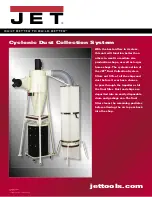
6
DUSTHOG PNP Series
3. Installation
3.1 Inspection and Off Loading
As soon as your equipment arrives, carefully inspect the items to ensure they are in good condition and
that all items listed on the packing list have been received. Even though the items are carefully loaded
and tied down at the time of shipment, it is possible for them to be damaged in transit.
Report any damage(s) and/or shortage(s) immediately. It becomes increasingly difficult for either the
carrier or the supplier to assume responsibility for any damages after too much time has transpired.
Check all loads separately.
The following steps should be taken immediately upon receipt of your shipment, which will assure and
expedite claim payments and replacement of missing or damaged items.
1. Begin your inspection of the shipment BEFORE it is unloaded.
2. Check for damage to any exposed items, particularly at the tie-down locations.
3. Photograph any damage. Do this BEFORE the equipment is unloaded.
4. Check Bill of Lading quantities and description. Note any discrepancies on all copies of the Bill of
Lading and have them acknowledged (the carrier should sign). Damage description should also be
written directly on, or attached to, the Bill of Lading, and should also be signed by the driver.
Contact the insurance company and the shipper at once so that damages and/or shortages can be
corrected and a claim can be filed without delay.
TIP OVER HAZARD
Lift the PNP unit and components by the packing skids or on the lifting eyes located on the top of the
unit in each corner.
3.2 Installation, Preparation, and Planning
Prior to the actual installation of the PNP, the location should be readied. This would include having an
adequate laydown area for all components, and access for the crane, forklifts and other machinery.
The unit will come mostly pre-assembled. The majority of installation will be ducting, mounting, or
securing the unit. An electrical source, lighting and other equipment should be readily available to aid in
the installation.
In most cases engineering drawings of your specific equipment and options will be provided. These
and all available documentation for your system should be thoroughly reviewed prior to beginning any
installation work. This includes the unit and electrical controls. Ensure to leave an appropriate amount
of room around your unit to allow for maintenance and servicing. A minimum of 2-1/2 feet (0.76 m)
of clearance is recommended for service in front of the filter access door and 3 feet (1 m) for the rear
electrical access per NEC.
Ensure there is adequate access to the electrical components with ducting installed.
Ensure to position the unit so that the clean air discharge is directed into an open area free of
obstructions and with consideration for personnel safety.
!
DANGER
Summary of Contents for DUSTHOG PNP
Page 1: ...DUSTHOG Plug Play Fume Dust Collector Owner s Manual Model PNP...
Page 6: ...Page intentionally left blank...
Page 11: ...7 DUSTHOG PNP Series 61 10121 Figure 2 PNP Weights and Lifting Info...
Page 27: ...23 DUSTHOG PNP Series Page intentionally left blank...
Page 29: ...25 DUSTHOG PNP Series PNP 12 Figure 24 PNP Replacement Parts 61 10123...
Page 30: ...26 DUSTHOG PNP Series A1 Transformer 575 480 8 Appendix Wiring Diagrams 04 001886...
Page 31: ...27 DUSTHOG PNP Series A2 One Blower Controls 04 001830...
Page 32: ...28 DUSTHOG PNP Series A3 Two Blower Controls 04 001831...
Page 33: ...29 DUSTHOG PNP Series A4 Three Blower Controls 04 001832...
Page 34: ...30 DUSTHOG PNP Series A5 Four Blower Controls 04 001881...
Page 35: ...31 DUSTHOG PNP Series A6 Remote Panel Controls 04 001868...
Page 36: ...32 DUSTHOG PNP Series A7 One Blower Remote Controls 04 001833 A7...
Page 37: ...33 DUSTHOG PNP Series A8 A8 Two Blower Remote Controls 04 001834...
Page 38: ...34 DUSTHOG PNP Series A9 Three Blower Remote Controls 04 001863...
Page 39: ...35 DUSTHOG PNP Series A10 Four Blower Remote Controls 04 001864...



































